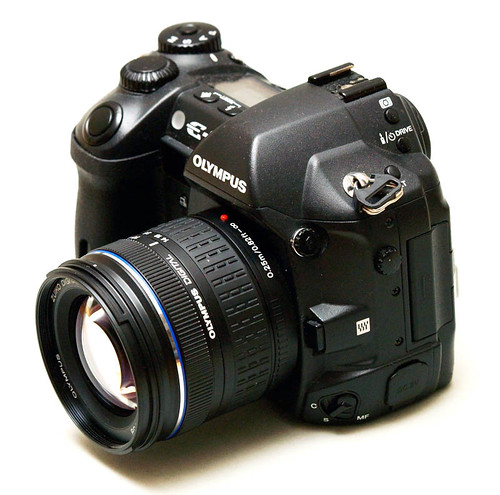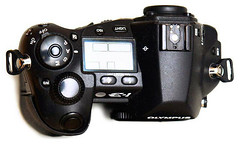Announced in June 2003, the Olympus E-1 was the first interchangeable lens DSLR for the Four-Thirds system. Released at a premium price point, the E-1 was aimed at the professional market and as such features dust and water-resistant weather-sealing (to match the majority of pro-level Four-Thirds lenses) and very high build quality and robustness, along with Olympus' patented SSWF dust reduction system. The camera features twin control dials, an external white-balance sensor, an external x-contact port and can be used with a vertical battery grip attachment.
Featuring a 5 megapixel CCD with the 4:3 aspect ratio, the E-1 has the same sized sensor as all cameras that share the Four-Thirds mount. Unlike all Four-Thirds cameras since its release except the E-3, the viewfinder in the E-1 is larger and offers 100% frame coverage – one of the main criticisms of the other cameras using the small Four-Thirds sensor.
E-1s have been used in various harsh environments such as deserts and war zones, and as of 2007 remain reportedly one of the toughest SLRs ever produced.
A successor to the E-1 was released in Nov 07 and is called the E-3.
Some brief specifications:
- 5 Megapixel CCD sensor — image dimensions up to 2560 × 1920 pixels (4.9mp effective)
- 1.8” rear LCD panel (134,000 pixels; 100% frame coverage)
- Olympus' patented 'Supersonic Wave Filter' anti-dust system
- Metering: 49 area ESP, Centre-weighted average, Spot (1.8%)
- External white-balance sensor
- Single AF, continuous AF and manual focusing with all Four-Thirds lenses
- Sequential shooting at 3fps up to 12 frames
- ISO range 100–3200.
- Program, Aperture Priority, Shutter Priority and Manual shooting modes
- Takes CompactFlash (Type I/II or MD) type memory cards
- No inbuilt flash
- Weight: 660g (body only)
- Size: 141 × 104 × 81mm
Links[]
- Specs and full review at DP Review
- First and second review at The Luminous Landscape
- Review at Steve's Digicams
- Olympus E-system at John Foster's Biofos website
- Olympus E-system at Andrzej Wrotniak's photo website
- Olympus E-1 at Lonestardigital

